Nicolas Sabouret
CPU, LISN
Mitigation of gender bias in automatic facial non-verbal behaviors generation
Oct 09, 2024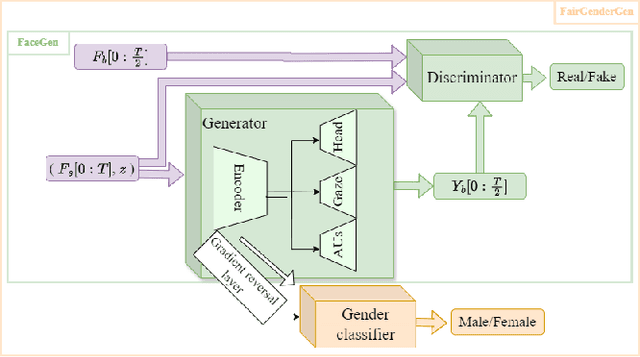


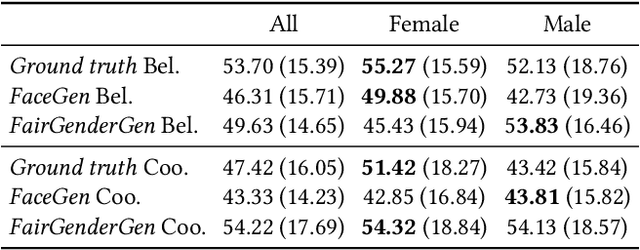
Abstract:Research on non-verbal behavior generation for social interactive agents focuses mainly on the believability and synchronization of non-verbal cues with speech. However, existing models, predominantly based on deep learning architectures, often perpetuate biases inherent in the training data. This raises ethical concerns, depending on the intended application of these agents. This paper addresses these issues by first examining the influence of gender on facial non-verbal behaviors. We concentrate on gaze, head movements, and facial expressions. We introduce a classifier capable of discerning the gender of a speaker from their non-verbal cues. This classifier achieves high accuracy on both real behavior data, extracted using state-of-the-art tools, and synthetic data, generated from a model developed in previous work.Building upon this work, we present a new model, FairGenderGen, which integrates a gender discriminator and a gradient reversal layer into our previous behavior generation model. This new model generates facial non-verbal behaviors from speech features, mitigating gender sensitivity in the generated behaviors. Our experiments demonstrate that the classifier, developed in the initial phase, is no longer effective in distinguishing the gender of the speaker from the generated non-verbal behaviors.
A multi-sourced data and agent-based approach for complementing Time Use Surveys in the context of residential human activity and load curve simulation
Dec 13, 2023



Abstract:To address the major issues associated with using Time-Use Survey (TUS) for simulating residential load curves, we present the SMACH approach, which combines qualitative and quantitative data with agent-based simulation. Our model consists of autonomous agents assigned with daily tasks. The agents try to accomplish their assigned tasks to the best of their abilities. Quantitative data are used to generate tasks assignments. Qualitative studies allow us to define how agents select, based on plausible cognitive principles, the tasks to accomplish depending on the context. Our results show a better representation of weekdays and weekends, a more flexible association of tasks with appliances, and an improved simulation of load curves compared to real data. Highlights $\bullet$ Discussion about Time-Use Surveys (TUS) limits and the use of TUS in activity and energy simulation $\bullet$ Presentation of complementary data both qualitative and quantitative used to complement TUS data $\bullet$ Proposition of an agent-based approach that balances these limitations
Interpreting social cues to generate credible affective reactions of virtual job interviewers
Feb 25, 2014
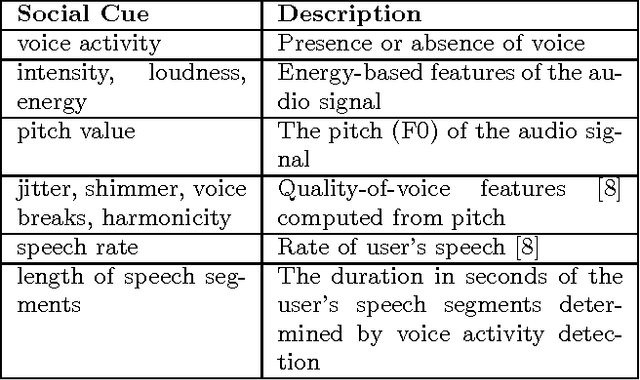
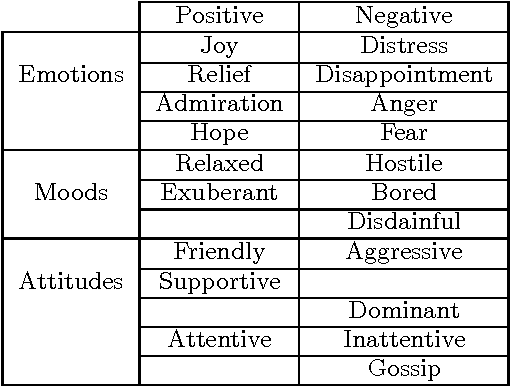
Abstract:In this paper we describe a mechanism of generating credible affective reactions in a virtual recruiter during an interaction with a user. This is done using communicative performance computation based on the behaviours of the user as detected by a recognition module. The proposed software pipeline is part of the TARDIS system which aims to aid young job seekers in acquiring job interview related social skills. In this context, our system enables the virtual recruiter to realistically adapt and react to the user in real-time.
Expressing social attitudes in virtual agents for social training games
Feb 20, 2014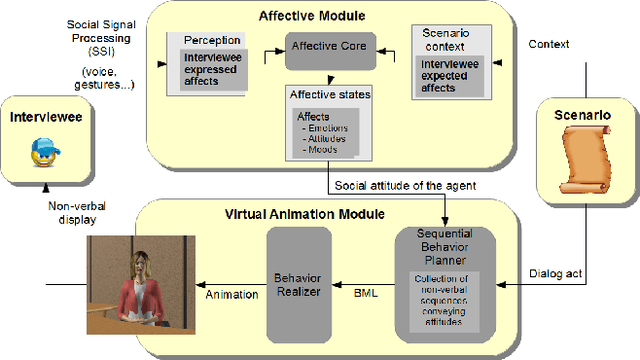
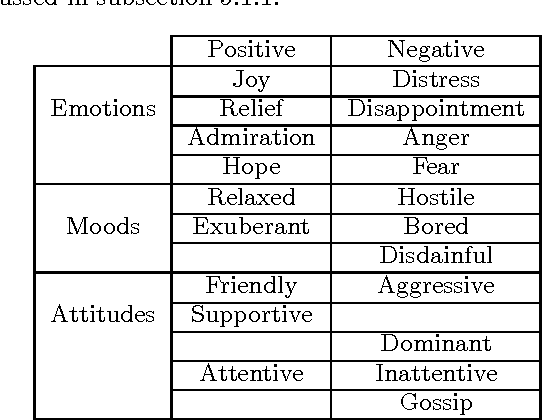
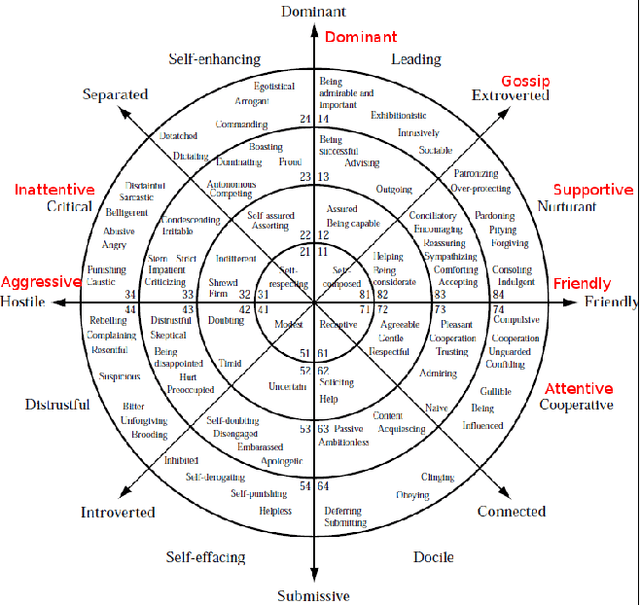

Abstract:The use of virtual agents in social coaching has increased rapidly in the last decade. In order to train the user in different situations than can occur in real life, the virtual agent should be able to express different social attitudes. In this paper, we propose a model of social attitudes that enables a virtual agent to reason on the appropriate social attitude to express during the interaction with a user given the course of the interaction, but also the emotions, mood and personality of the agent. Moreover, the model enables the virtual agent to display its social attitude through its non-verbal behaviour. The proposed model has been developed in the context of job interview simulation. The methodology used to develop such a model combined a theoretical and an empirical approach. Indeed, the model is based both on the literature in Human and Social Sciences on social attitudes but also on the analysis of an audiovisual corpus of job interviews and on post-hoc interviews with the recruiters on their expressed attitudes during the job interview.
A logical model of Theory of Mind for virtual agents in the context of job interview simulation
Feb 20, 2014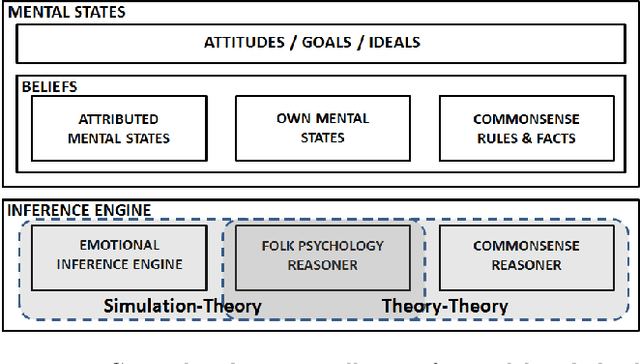
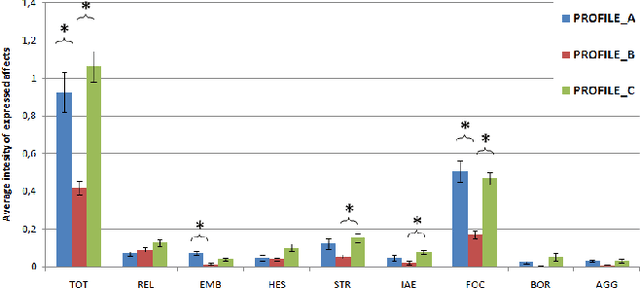
Abstract:Job interview simulation with a virtual agents aims at improving people's social skills and supporting professional inclusion. In such simulators, the virtual agent must be capable of representing and reasoning about the user's mental state based on social cues that inform the system about his/her affects and social attitude. In this paper, we propose a formal model of Theory of Mind (ToM) for virtual agent in the context of human-agent interaction that focuses on the affective dimension. It relies on a hybrid ToM that combines the two major paradigms of the domain. Our framework is based on modal logic and inference rules about the mental states, emotions and social relations of both actors. Finally, we present preliminary results regarding the impact of such a model on natural interaction in the context of job interviews simulation.
 Add to Chrome
Add to Chrome Add to Firefox
Add to Firefox Add to Edge
Add to Edge